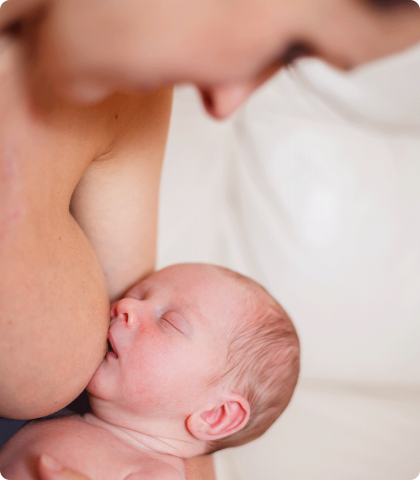The First Hour
The first hour after the birth is a highly significant time for the new parents and the baby. The woman's body releases lifetime high levels of the hormones involved in mothering, bonding and dependency. Her brain is uniquely sensitive to the effects of these chemicals during for first 60 mintues after birth. The baby's brain is also bathed in these chemicals. This makes their first contact as satisfying and rewarding as possible.
The birth is not yet complete. The placenta gradually strips itself from the wall of the uterus and is pushed out of the woman's body by contractions, felt as cramps. A decision needs to be made about how this stage is managed. The baby's body undergoes enormous adaptations in its breathing and blood circulation, everything has changed. The only constant is the voice of the mother and the baby recognises this.
Researchers have carefully studied this first hour and found that babies move through specific stages as they adapt to the world. You can read more here.
Increased sensitivity
Both the mother’s and baby’s oxytocin and endorphin levels increase during labour, but the mother’s oxytocin level soars after the birth, reaching lifetime high levels which remain elevated for 60 minutes. The number of oxytocin receptors in the mother’s brain also increased during labour, making her brain hyper-sensitive to the effects of oxytocin after the birth. Oxytocin has been dubbed 'the hormone of love' or 'the cuddle hormone' due to its role in human relationships. The mother’s and baby’s endorphin levels also increase during labour and remain high for the first 30 minutes. Endorphin along with dopamine create the good feelings which bond human beings together. The special role played by oxytocin is to create a lasting association between the pleasurable experience and the person who triggered it. Physiological birth creates a sensitive period for mother and baby attachment which is helped along by skin-to-skin contact after the birth. The mother's chest is the warmest place for the baby, because one of the physical effects of oxytocin is to bring more blood to the area.
Checking the baby
As soon as your baby is born, your midwife or doctor will make an assessment of their health, just by observation. The first set of observations is performed immediately after the birth. The midwife or doctor will look for information about how easily your baby is breathing, how they move their arms and legs, how they respond to the stimulation of your touch, the strength of their heart rate and their colour. This is called the Apgar Score and each of these factors is given a score from 0-2 and added together. A healthy baby at birth has an Apgar Score of 7 or above. Baby's with scores lower than 7, may need some help to make a safe transition from womb to world. These observations are made again 5 minutes after the birth. Scores at 5 minutes, tend to be higher than those given immediately after the birth.
Giving birth to the placenta
Meanwhile, inside the mother's body, the placenta separates from the wall of the uterus, a process which began with the final birthing contractions. The mother's rising oxytocin levels stimulate the uterus to continue to contract, though now the contractions are felt only as cramps. The size of the uterus reduces with each contraction and this compresses the placenta. The blood vessels which supply the placenta are constricted by the contractions, reducing the mother’s risk of blood loss. A large blood clot forms behind placenta which makes it heavier and so gravity helps to strip the placenta away from the wall of the uterus.
The placenta falls first into bottom of uterus, and is then pushed into the birth canal by the contractions. The birth of the placenta takes around 20 – 60 minutes. The high levels of nor-adrenaline from the birth drop rapidly and this can give some women the shakes for a short time.
Adapting to the world
The baby is going through an amazing transition. Blood is diverted from the umbilical cord and placenta and sucked into the baby’s major organs such as the lungs and brain. There is a reservoir of blood in the placenta and cord designed for this purpose. It is like having a blood transfusion, as the baby receives 30% additional blood during this time! Each contraction pumps blood to the baby via the cord and extra blood returns to the placenta if it is not needed. The baby’s cord will continue to pulsate whilst the transfusion continues. Sometimes this is a short time, only a minute or so, but the cord can pulsate for 4 or 5 minutes whilst the baby receives the blood it needs.
Beginning breastfeeding
If the baby is left undisturbed on its mother's chest, it will start to breastfeed within one to two hours of the birth. Breastfeeding behaviours are all reflexes. Reflexes are movements which are directed by the baby's nervous system in response to a physical stimuli rather than being concious. Drugs offered for pain relief in labour can interfere with this process and may suppress the baby's reflexes until its body has processed the chemicals. Typically, within just 15 minutes of the birth, babies spontaneously start to suck and make the movements which are associated with the 'rooting' reflex. These involve opening the mouth and moving the head from side to side. These behaviours build up over the course of the first hour. The baby brings their hands to their mouth within 40 minutes of the birth and might reach the nipple and beginning to suckle within an hour of the birth.
When babies are able to lead attachment to the breast within the first few hours after birth, these reflexive movements become 'conditioned' skills and this has been shown to reduce the chances of later problems with attachment (Australian Breastfeeding Association 2008:52).
Routine intervention
The Active Management of the Third Stage of Labour is a routine intervention which is offered to all women who give birth in hospital labour wards. This intervention involves an injection of artificial oxytocin into the mother's thigh with the birth of the baby's second shoulder. If the woman already has an intravenous drip in place then the medication is given using this. As soon as the baby is born, the umbilical cord is clamped and cut. Once the cord begins to length because the placenta has dropped into the bottom of the uterus, the midwife or doctor gently pull on it in order to speed up the birth of the placenta and membranes.
Advantages for the Woman
- Reduces the risk severe postnatal bleeding for all risk types of women by 50% (Enkin et al. 2000 and Begley at al.2011 link)
Disadvantages for the Woman
- When only low risk women were studied there were no differences between women who had the injection and those who did not (Begley at al.2011 link and RCOG 2009).
- One large New Zealand study of over 30,000 low risk women (Dixon et al.2009) and a smaller study in New South Wales (Fahy et al.’s 2010), found that it increased the risk of blood loss.
Other unwanted effects included an increase in:
- blood pressure;
- after pains;
- nausea and vomiting;
- the use of medication for pain relief in the postnatal period;
- the number of women readmitted to hospital with vaginal bleeding was increased Begley at al.2011 link).
Advantages for the Baby
- The research does not highlight any statistically significant benefits for the baby.
Disadvantages for the Baby
- Babies have a reduced birth weight, attributed to the loss of up to 80 mls of infant blood which is retained in the placenta due to early cord clamping (Farrar et al. 2009).
References
- Australian Breastfeeding Association (2008). Breastfeeding naturally. Second Edition. Ed. Day, J. Australian Breastfeeding Association: Melbourne.
- Begley CM, Gyte GML, Murphy DJ, et al. (2011) Active versus expectant management for women in the third stage of labour. Cochrane Database of Systematic Reviews, Issue 11. Chichester: John Wiley and Sons (link)
- Dixon, L., Fletcher, L., Tracey, S., Guilliland, K., Pairman, S. and Hendry, C. (2009) Midwives’ care during the third stage of labour. New Zealand College of Midwives, 41: 20-5.
- Enkin, M., Kierse, M., Neilson, J., Crowther, C., Duley, L., Hodnett, E., and Hofmeyr, J. (2000) A Guide to Effective Care in Pregnancy and Childbirth. Oxford: Oxford University Press.
- Fahy, K., Hastie, C., Bisits, A., Marsh, C., Smith, L. and Saxton, A. (2010) Holistic physiological care compared with active management of the third stage of labour for women at low risk of postpartum haemorrhage: a cohort study. Women and Birth, 23: 145-52.
- Farrar D, Airey R, Tuffnell D, Law G, Cattle B, Duley L. (2009). Measuring Placental Transfusion For Term Births: Weighing Babies With The Cord Intact. Arch Dis Child Fetal Neonatal Ed 2009, 94:Fa7. OpenURL.
- Royal College of Obstetricians and Gynaecologists (2009) Prevention and Management of Postpartum Haemorrhage. Available online at http://www.rcog.org.uk/files/rcog-corp/GT52PostpartumHaemorrhage0411.pdf. [Accessed on 12 September 2013].
QUICK FACTS
60 minutes
The length of time that the mother's oxytocin levels are elevated immediately after the birth.
0%
The percentage of severe post-birth bleeds prevented in low risk women by the Active Management of the Third Stage procedure.
80 millilitres
The amount of additional blood pumped to the baby by the placenta, if the umbilical cord is left unclamped whilst still pulsating.

